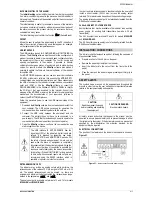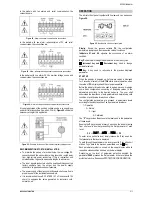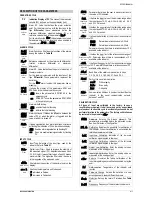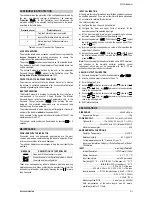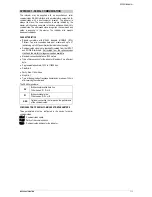
N1040i Indicator
NOVUS AUTOMATION
4/7
DESCRIPTION OF THE PARAMETERS
OPERATION CYCLE
PV
Indication Display of PV
. The value of the measured
variable (PV) is shown on the upper display (red).
Sp.a1
Sp.a2
SetPoint
Alarm
Alarm SP: Value that defines the alarm activation
point. For the alarms set up with the functions of the
type
Differential
, these parameters define the
maximum differences accepted between PV or a
reference value defined in the parameter
ALrF
.
For the alarm function
ierr
, this parameter is not used.
Parameters shown in this level only when enabled in
the parameters
sp1.E
and
sp2.E
.
ALARMS CYCLE
Fva1
Fva2
Function
Alarm
Alarm Functions. It defines the functions of the alarms
among the options in
Table 02
.
al.rf
Alarm
Reference
Reference value used by the alarms with differential
function, minimum differential or maximum
differential.
Sp.a1
Sp.a2
SetPoint
Alarm
Alarm SP: Value that defines the point of activation of
the alarm outputs.
For the alarms programmed with the functions of the
type
Differential
, these parameters represent the
deviations.
For the
ierr
alarm function, this parameter has no
meaning.
Sp1.e
sp2.e
SP Enable
It allows the display of the parameters SPA1 and
SPA2 also in the indicator operation cycle.
YES
shows the parameters SPA1/SPA2 in the
operation cycle
NO
DOES NOT show the parameters SPA1/SPA2
in the operation cycle
bla1
bla2
Blocking Alarm
Alarms Initial Blocking.
YES
enables the initial blocking
NO
inhibits the initial blocking
xya1
xya2
Hysteresis of
Alarm
Alarm Hysteresis. It defines the difference between the
value of PV at which the alarm is triggered and the
value at which it is turned off.
flsh
Flash
It allows signalization of an alarm conditions occurrence
by flashing the indication of PV on the indication display.
YES
Enables alarm signalization by flashing PV.
NO
Does not enable alarm signalization by flashing
PV.
INPUT CYCLE
Type
Type
Input Type. Selection of the input type, used by the
indicator. Refer to
Table 01
.
fltr
Filter
Digital Input Filter – Used to improve the stability of
the measured signal (PV). Adjustable between 0 and
20. At 0 (zero) it means filter turned off and 20 means
maximum filter. The higher the filter value, the slower
is the response of the measured value.
Dp.po
Decimal Point
It determines the position of the decimal point on the
display.
vn
i
t
Unit
It defines the temperature unit to be used:
(
indication in Celsius.
f
indication in Fahrenheit.
0ffs
Offset
Parameter that allows the user to make corrections in
the value of PV indicated.
inll
Input Low
Limit
It defines the lower value of the indication range when
the input types of 0-20 mA, 4-20 mA, 0-50 mV, 0-5 V
and 0-10 V are used.
inxl
input High
Limit
It defines the upper value of the indication range when
the input types of 0-20 mA, 4-20 mA, 0-50 mV, 0-5 V
and 0-10 V are used.
Retr
Retr
ansmission
It allows the definition of the mode of retransmission
of PV.
P020
Determines retransmission in 0-20 mA.
P420
Determines retransmission in 4-20 mA.
Parameter shown when there is retransmission of PV
available on the indicator.
Rtll
Retransmission
Low Limit
It defines the lower limit of the retransmission range of
PV. Parameter shown there is retransmission of PV
available on the indicator.
Rtkl
Retransmission
High Limit
It defines the upper limit of the retransmission range
of PV. Parameter shown there is retransmission of PV
available on the indicator.
bavd
Baud Rate
Baud Rate of the serial communication. In kbps.
1.2, 2.4, 4.8, 9.6, 19.2, 38.4, 57.6 and 115.2
prty
Parity
Parity of the serial communication.
none
Without parity
Even
Even parity
0dd
Odd parity
Addr
Address
Communication Address. A number that identifies the
indicator in the serial communication network,
between 1 and 247.
CALIBRATION CYCLE
All types of input are calibrated in the factory. In case a
recalibration is required; it shall be carried out by a specialized
professional. In case this cycle is accidentally accessed, do not
perform alteration in its parameters. The factory calibration can
be restored in the parameter
rstr
.
pass
Password.
Entering the Access password. This
parameter is presented before the protected cycles.
See item Protection of Configuration.
(alib
Calibration.
Enables the possibility for calibration of
the indicator. When the calibration is not enabled, the
related parameters are hidden.
inL(
Input Low Calibration.
Indication of the low scale
calibration signal applied to the input.
ink(
Input High Calibration.
Indication of the full scale
calibration signal applied to the input.
ovL(
Output Low Calibration.
Enter the analog value as
measured at the analog output.
ovk(
Input High Calibration.
Enter the analog value as
measured at the analog output.
rstr
Restore.
It restores the factory calibrations of the
input, disregarding any modifications carried out by the
user.
(j
Cold Junction.
Temperature of the indicator cold
junction.
Pas.(
Password Change
. It allows the definition of a new
access password, always different from zero.
Prot
Protection
. Sets up the Level of Protection. See
Table
03
.
Freq
Frequency.
Frequency of the local electrical network.


